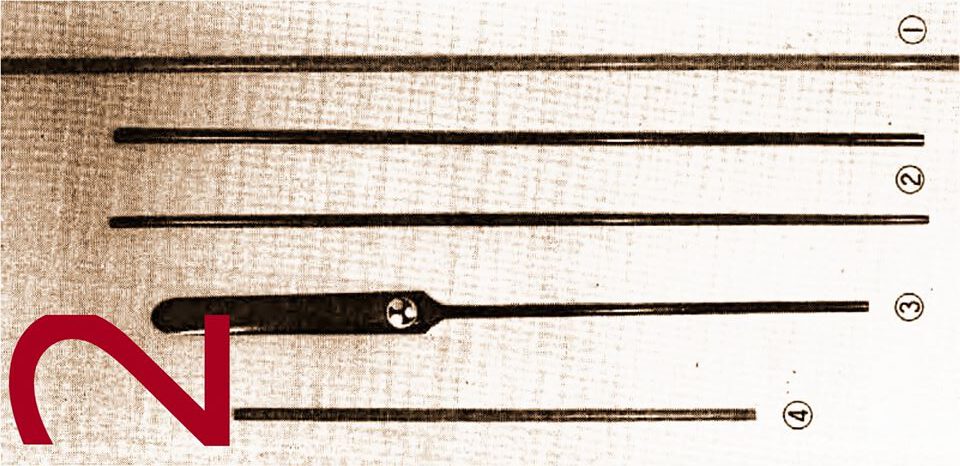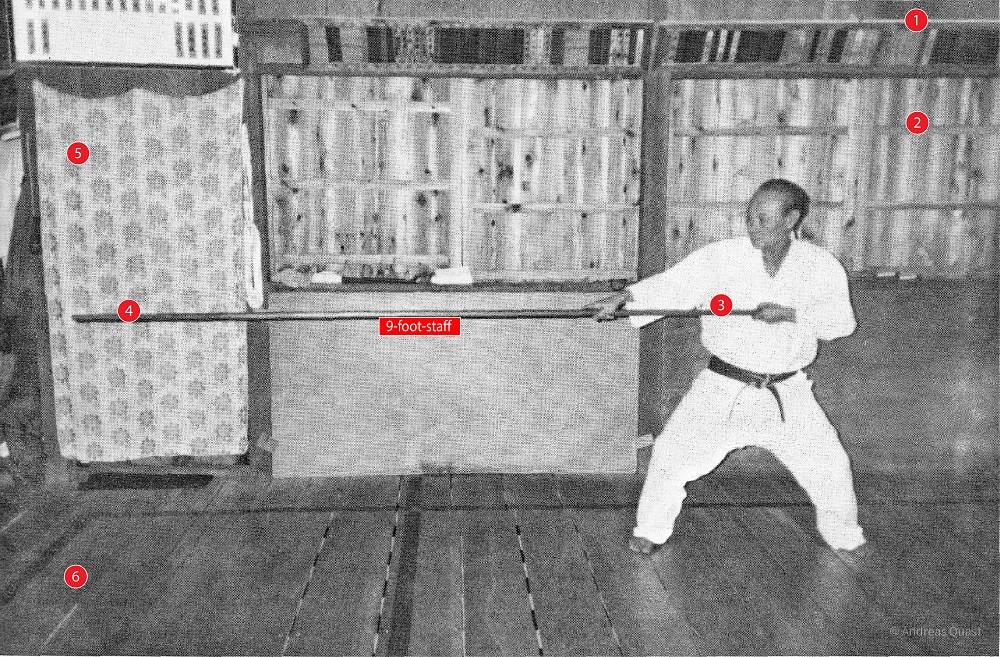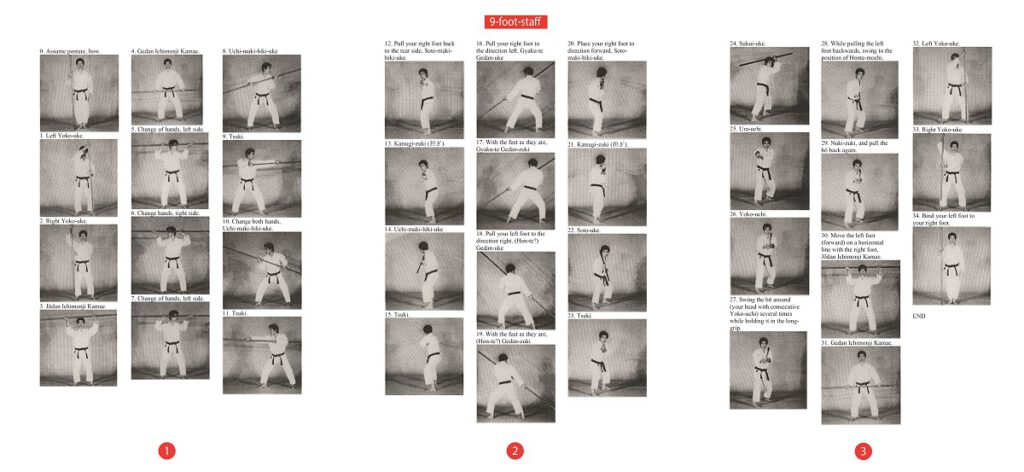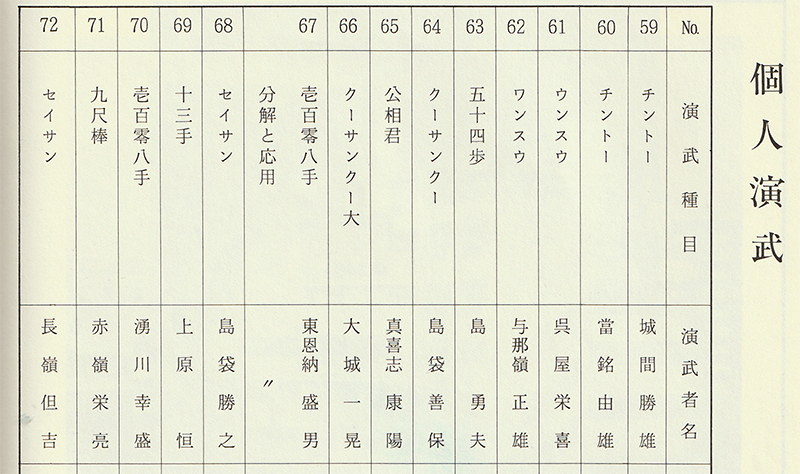I have written about the 9-foot-staff before. In the bōjutsu tradition of Taira Shinken, it is called the kushaku-bō. This staff is about ca. 273 cm long. I want to recapitulate on what I have established before and extend it a little bit.
In written sources, the 9-foot-staff first appears in 1964, when Taira Shinken mentioned it as one of the kata that still existed in Okinawa at that time. Moreover, on an unnumbered leaf of Taira’s book is a photo entitled “Various old weapons,” on the bottom of which the 9-foot-staff (photo 1: Upper row: Sai, Nunchaku, Suruchin, Kusarigama. Lower row: Dai-nunchaku, Rokushaku-bō, Kushaku-bō) (Taira 1964: unnumbered leaf 9). I believe this particular photo was taken in the dōjō of Inoue Motokatsu.

Photo 1: Upper row: Sai, Nunchaku, Suruchin, Kusarigama. Lower row: Dai-nunchaku, Rokushaku-bō, Kushaku-bō) (Taira 1964: unnumbered leaf 9)
Finally, in chapter 4, Taira wrote that “The staff can be roughly classified into three kinds: 3-foot-staff, 6-foot-staff, and 9-foot-staff.” (Taira 1964: 42)
More than 30 years later, in a posthumously published bequest of Taira, the “9-foot-staff (thrusting staff)” is specified as a one of the “Types of Practices in the Ryūkyū Kobudō Hozon Shinkōkai” (Taira 1997: 195-98).
Note that “thrusting staff” (tsuki-bō) was added to it. Therefore, the representative technique of the 9-foot-staff appears to be the thrust (tsuki), which makes sense for a weapon of this length. It may be comparable to the European pike, the Japanese yari, and the Wing Tsun long-pole. Indeed, later it became generally accepted that the “9-foot-staff (thrusting staff)” belonged to the kata that derived their name from their most characteristic technical feature (see OKKBH 1994: 41; Nakamoto Masahiro and Tsuha Kiyoshi, in OKKJ 2008: 302).
Inoue Motokatsu mentioned the 9-foot-staff, providing us with another contextual perspective, saying that it belongs to the category of long weapons (Inoue 1972: 1-2), as opposed to short weapons (such as kama and sai) and flexible weapons (such as nunchaku and suruchin).

Photo 2: 1. Kushaku-bō, 2. Bō or Kun, 3. Sunakake-bō (Uēku), 4. Sanshaku-bō (Photo from: Inoue 1972: 23).
Nakamoto Masahiro of Bunbukan also mentioned it in his list of “Kata of Bōjutsu Preserved in Today’s Okinawa” (Nakamoto 2007: 92), and there are more and more works that adopt it.
The Okinawa Karate Kobudō Encyclopedia adds another definition: “9-foot-staff: also called bajōbō, i.e. a fencing pole the length of a horse, or otherwise a staff of a length of ca. 3 m (= 1 jō = 10 shaku)” (OKKJ 2008: 317).
Besides printed matter, the term “9-foot-staff” also appears otherwise, such as in this kata list once written by Akamine Eisuke (see pic 3). Actually, in the new Shimbukan dōjō of Akamine Hiroshi sensei, a 9-foot-staff wrapped in a soft case leaned on the dōjō’s front side between at least 2010 and 2012 (see pic 4, featuring Akamine sensei). I never saw the 9-foot-staff being used, though and it is unclear to me whether its techniques have been handed down in personal instruction or not.

Photo 3: Kata list once written by Akamine Eisuke
Finally, according to some sources, the 9-foot-staff is only found in kobudō bōjutsu, but not in any of the traditional village bōjutsu (mura-bō) (OKKBH 1994: 78. Hokama 1999: 182-83).
As described above, since Taira Shinken’s description in 1964, the “9-foot-staff” appeared in various literary sources.
Then, how did the 9-foot-staff become a type of kobudō? In an interview in 1997, Akamine Eisuke was asked about training as a young man in his home village of Kakazu, where he started training in kobudō when he was 16 years old, that is, in 1941 or 1942. He probably trained there until being drafted into the Imperial Japanese Army. While I have no reliable data, the internet says he was sent to Taiwan in 1944. Only three regiments of the IJA served in Taiwan at the time.
- 46th Infantry Regiment of the 6th Imperial Army Division (HQ in Ōmura)
- 1944/11: Moved to Taiwan and guarded Kaohsiung.
- 1945: Transferred to Okayama area.
- August – End of the war
- 24th Infantry Regiment of the 12th Imperial Army Division (HQ in Fukuoka)
- 1944/12: The main force of the regiment is transferred to Kaohsiung, Taiwan.
- 1945/08: End of war
- 48th Infantry Regiment of the 12th Imperial Army Division (HQ in Kurume)
- 1944/11: Moved to Taiwan
- 1945/08 – End of the war
Since the allied forces bypassed Taiwan and instead landed on the island of Okinawa, all the above regiments reached the end of the war without combat during that time.
In relation to the Kakazu hamlet, Akamine Eisuke said the following in the above-mentioned interview.
“There was a tug-of-war. At the time of the tug-of-war, the hamlet was divided into East and West, and everybody did the battle of the bō. [It was what is] kumite now, and was called uchāshibō. It was an exchange of blows in real earnest. If you were negligent, you were injured. All the young men (seinen) of the hamlet participated. The bō was a 6-foot-staff. […] There was the 3-foot-staff. There is no kata for the 9-foot staff. At the time of tug-of-war, there was also Okinawa sumō wrestling. I also participated in shima (Okinawa sumō).”
He describes a typical village bōjutsu tradition typically related to annual festivals such as tug-of-war, and which included kumi-bō, for which the 6-foot-staff was used and some of which might have served as a model for the bō vs bō promised kumite still in use in Okinawan Taira lineage. Besides, there were also 3-foot-staffs, and the 9-foot-staff existed as well, however, no kata existed for the latter.
It remains unclear whether Akamine in his description refers to the time when he started training in 1941 or 1942, or to the time after he returned to Okinawa sometime after 1945 and resumed bōjutsu in Kakazu village. Anyway, asked about whether there is a kata for the 9-foot staff, Akamine answered,
“The 9-foot staff is said to have been used while riding on horseback in the old days. Originally it was mainly a thrusting technique (tsuki-waza, nuki-waza). I never used it with kata in the same way as with the 6-foot staff.”
In short, Akamine Eisuke did not use kata for the 9-foot staff, but trained it mainly by thrusting it.

1: Name tag board. 2. Wooden window shutters. 2. Long grip at the end. 4. Front tip, bo horizontal. 5. Curtain. 6. Wooden planks.
Anyway, in a recent short video entitled “Introduction of Rare Kata”, Nakamoto Mamoru sensei of the Okinawa Dentō Kobudō Hozonkai Bunbukan introduced a short extract of “Yabiku no Naga-bō” (The long m staff of Yabiku”), with reference to Yabiku Mōden, teacher of Taira Shinken.
In this connection, as shared by fellow kobudō practitioner Walt Young, the 9-foot-staff is also found in the Ufuchiku-Den Kobujutsu of Isa Kaishu, where it is one of the last weapons to learn. Walt’s understanding is that it is mainly for thrusting as well and also adds in preparing you for yield the follow on double-sided nuntesubō (6-foot-staff with nuntesu (nunti) on each end) which is over 8 feet in length as well. According to Walt, Ufuchiku Sensei was the caregiver of the Royal horses when the last king Shō Tai moved to Tokyo. Oral and written history also has it that Yabiku Mōden trained with Ufuchiku as well, as can be seen in the personal relations described in Taira lineage Ryūkyū Kobudō. So there might have very well been techniques or even a kata of the 9-foot-staff by the late 19th and early 20th centuries, which have spread across different lineages.
Moreover, as mentioned above, Taira Shinken’s disciple Inoue Motokatsu also recorded a kata of the 9-foot-staff in word and picture (Inoue 1974: 353-364).

Kata of the 9-foot-staff in word and picture (Inoue 1974: 353-364)
Finally, in 1987, Akamine Eisuke performed 9-foot staff at the 1st Okinawa Karate Kobudo Enbu Taikai held at Ryukyu Shinpo Hall. Some documentation or footage of it might remain somewhere.
Courtesy of Yannick Schultze-Nadoyama.
© 2023, Andreas Quast. All rights reserved.

